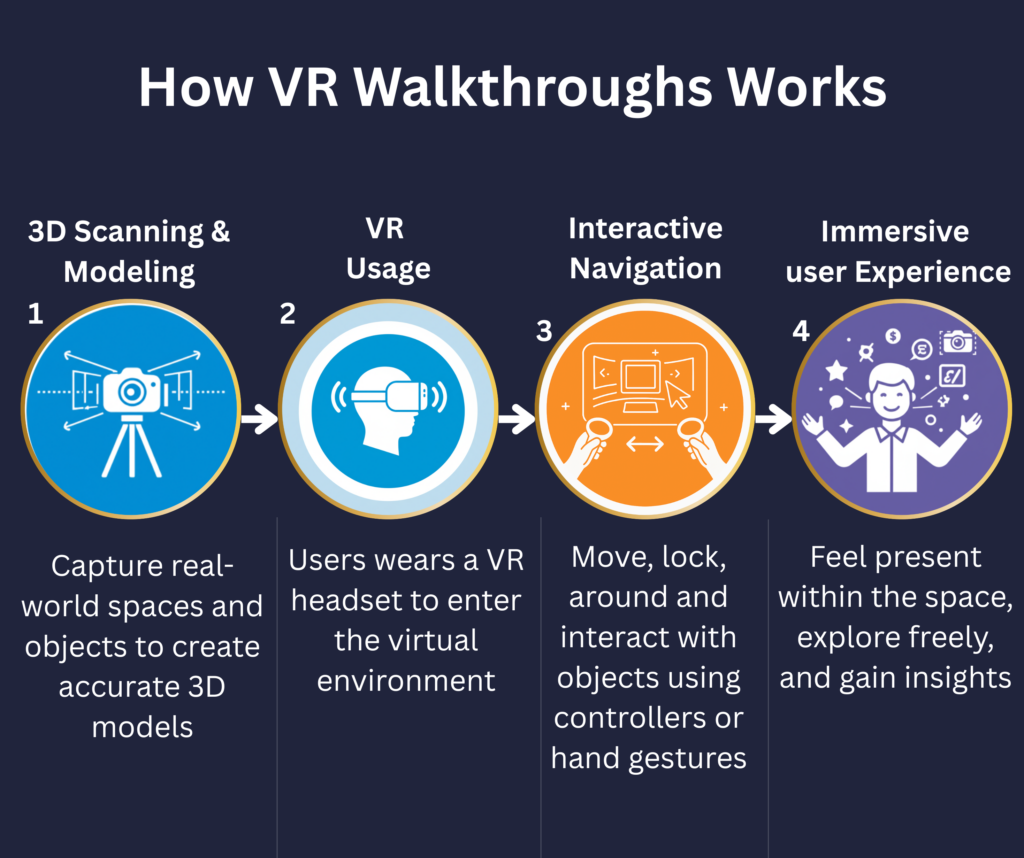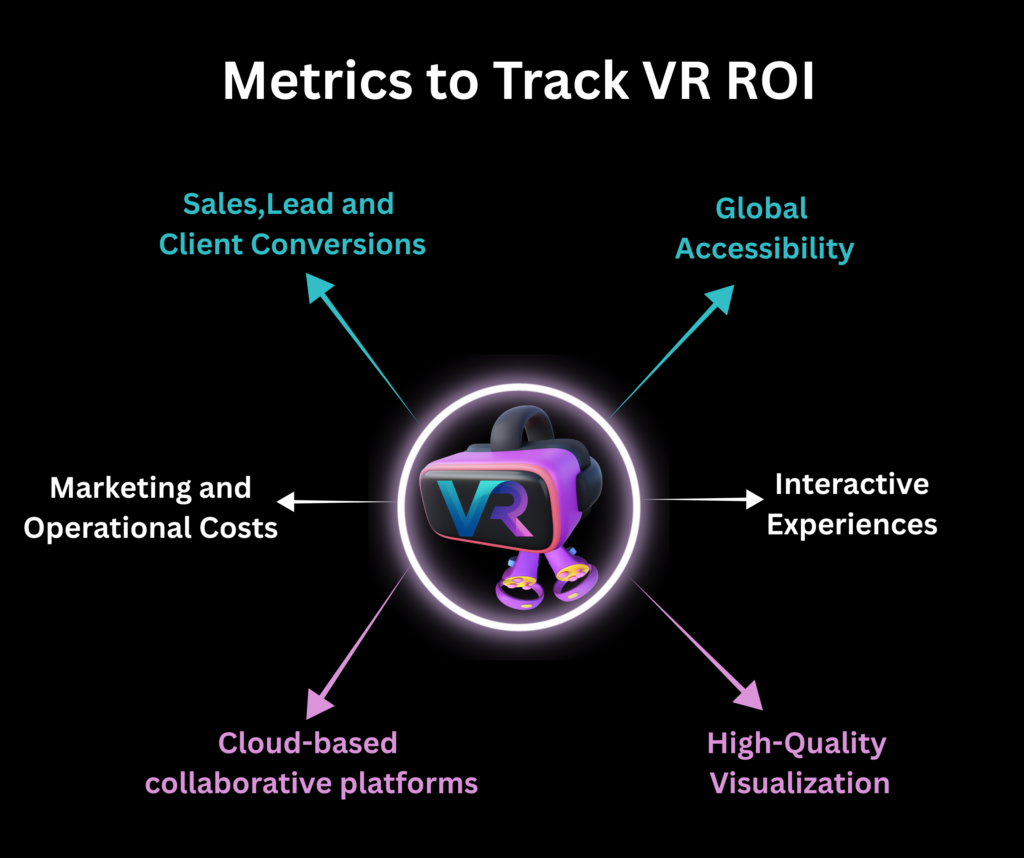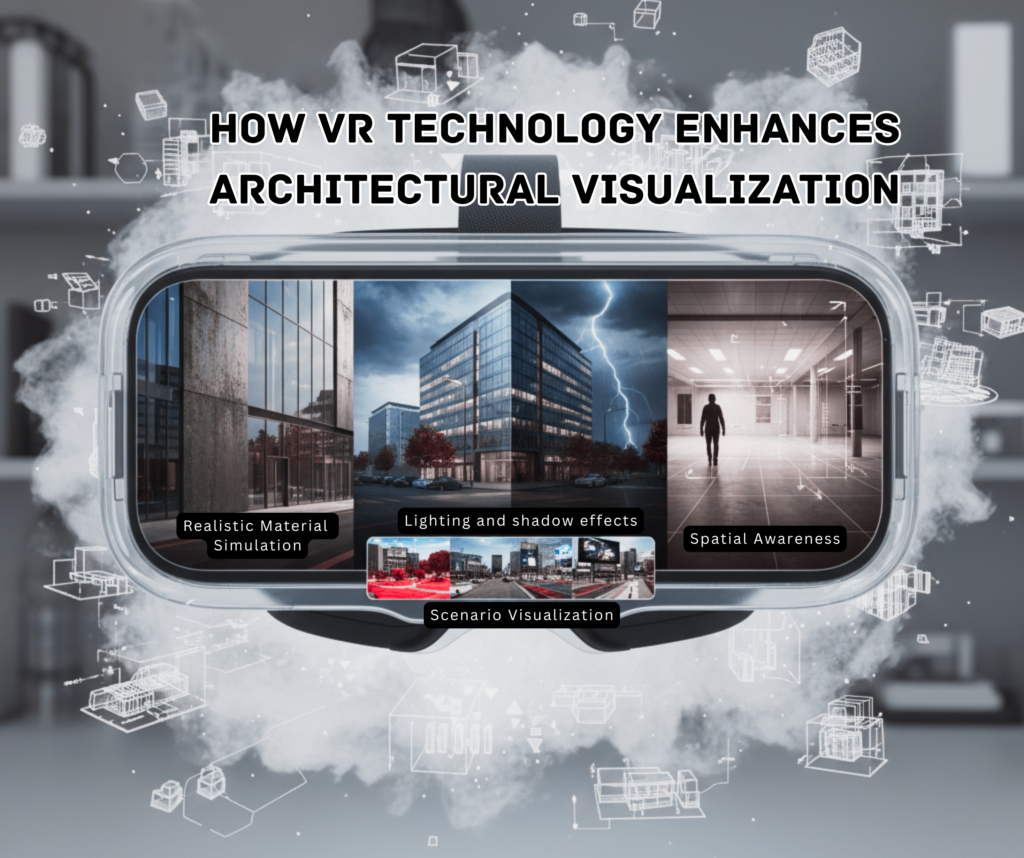From saving time and reducing operational costs to enhancing client experience and engagement, the debate between virtual reality walkthroughs and traditional site visits is no longer just a trend, it’s a strategic choice for property professionals looking to maximise ROI. In this article, we’ll break down the value, benefits, and limitations of both methods and explain why VR walkthroughs are increasingly becoming the go-to solution in Australia.
Understanding VR Walkthroughs
A VR walkthrough is an immersive digital experience that allows clients and stakeholders to explore a property virtually before it’s built. Unlike traditional 2D floor plans or static renders, VR walkthroughs provide a 3D interactive environment, giving a true sense of space, scale, and design.
For architects and developers in Australia, VR walkthroughs are particularly valuable for high-end residential projects, commercial developments, and luxury properties, where clients want to experience every detail from finishes to lighting. With VR, you can showcase your property to potential buyers or investors anywhere in the country without requiring them to visit the site physically.

How VR Walkthroughs Works
VR walkthroughs rely on advanced 3D modelling and rendering technologies. Architects and designers create detailed digital models of the property, including materials, furniture, and landscaping. These models are then integrated into a VR platform, which can be accessed via VR headsets, desktop computers, or even mobile devices.
Modern VR solutions often include cloud-based rendering, enabling multiple stakeholders clients, contractors, and investors—to collaborate in real time. This technology ensures that everyone sees the same accurate representation of the property, allowing for efficient decision-making and project approvals.
VR Walkthroughs for Developers and Clients
- Time-saving: Clients can experience multiple properties virtually in a single session without the need for travel.
- Cost-efficient: Reduces the need for repeated on-site visits and expensive printed marketing materials.
- Enhanced engagement: Clients can interact with spaces, experiment with finishes, and visualise layouts before construction begins.
- Accessibility: Enables international investors or remote buyers to view properties as if they were physically present.
What is a Traditional Site Visit?
A traditional site visit involves physically inspecting the property or construction site. Clients walk through the space, experience its layout, and observe materials and finishes firsthand. For architects and developers, these visits provide opportunities to address concerns, showcase quality, and build trust.
While still widely used in Australia, especially for premium or complex projects, traditional site visits have limitations in terms of time, cost, and accessibility, particularly for clients located far from the site.
Personal interaction: Direct engagement with clients and stakeholders helps build relationships.
Tangible experience: Clients can feel materials, textures, and spaces in real life.
Detailed assessment: Enables inspection of structural elements, finishes, and any on-site challenges.
Limitations of Traditional Site Visits
- Time-consuming: Multiple visits can slow down decision-making and project approvals.
- Higher costs: Travel, accommodation, and logistics for clients or stakeholders add up.
- Limited reach: International or interstate clients may face difficulty in attending.
- Visualization challenges: Clients often struggle to fully imagine completed interiors, landscapes, or design options.
Cost and Time Efficiency Comparison
VR walkthroughs offer significant cost and time advantages. While the initial setup requires professional 3D modelling and VR integration, the savings from eliminating repeated physical site visits and printing materials quickly outweigh the costs.
Traditional site visits, on the other hand, require scheduling, travel, and client coordination, which can slow down project timelines. For Australian developers, using VR can reduce marketing and operational costs while accelerating project approvals and client engagement.
Client Experience and Engagement
One of the strongest advantages of VR walkthroughs is the enhanced client experience. Clients can explore spaces at their own pace, experiment with materials and finishes, and visualise the final outcome more accurately than with physical visits.
While traditional site visits offer a tactile experience, VR ensures that clients anywhere in Australia—even international buyers—receive the same high-quality, immersive presentation, which can significantly increase engagement and satisfaction.
Decision-Making and Project Approvals
VR walkthroughs also streamline decision-making. Stakeholders can provide instant feedback, approve designs, or request changes virtually, reducing the likelihood of costly errors during construction.
Traditional site visits often require multiple meetings and on-site inspections, which extend project timelines and increase the risk of miscommunication. For Australian developers and architects, adopting VR can result in faster approvals, fewer revisions, and smoother project delivery.
How VR Reduces Marketing and Operational Costs
By using VR walkthroughs, developers can minimise marketing expenses, reduce the need for physical staging, and limit travel for clients and staff. A single virtual model can serve as a powerful marketing tool across multiple channels, including websites, social media, and investor presentations.
Enhancing Sales and Client Conversions
Immersive VR experiences shorten the sales cycle. Buyers and investors gain confidence in their decisions, which leads to faster conversions and fewer abandoned projects. In the Australian luxury property market, VR walkthroughs are particularly effective for high-end residential, commercial, and off-the-plan developments.
Future of VR in Architecture and Real Estate
The adoption of VR in Australia is just the beginning. Augmented reality (AR), real-time updates, and cloud-based collaborative platforms are shaping the next generation of property marketing and design. Early adoption of VR not only improves current ROI but also positions developers and architects as innovators in the competitive property landscape.

Metrics to Track VR ROI
Investing in VR walkthroughs can be expensive, so tracking the right metrics is critical to measure return on investment (ROI). Here are the key metrics developers and architects should monitor:
- Lead Conversion Rate: Compare the number of inquiries generated from VR walkthroughs versus traditional methods.
- Client Decision Time: Track how long clients take to approve or commit to a project after experiencing a VR tour.
- Sales Volume Impact: Measure the increase in property sales or project approvals linked to VR presentations.
- Engagement Metrics: Monitor time spent by clients exploring VR tours, including clicks, interactions, and repeat visits.
- Cost Savings: Calculate reductions in travel, on-site staff hours, and preparation costs.
- Marketing Performance: Assess social media and digital marketing engagement generated by VR content.
Combining VR with Physical Site Visits
While VR walkthroughs are highly effective, some clients still prefer physical evaluation for tactile experience. Combining VR with traditional site visits offers the best of both worlds:
- Conduct initial VR walkthroughs to screen potential buyers or stakeholders.
- Schedule physical site visits for clients who require tactile verification of materials, finishes, and layouts.
- Use VR to pre-visualize design options, allowing clients to make decisions before visiting the site.
- Streamline site visits to focus only on critical touchpoints, reducing time and costs.
Choosing the Right VR Software Platform
Selecting the right VR platform is crucial for quality, usability, and ROI. Consider these factors:
- Compatibility: Supports multiple devices, including VR headsets, desktops, and mobile devices.
- Ease of Use: Simple interface for both clients and internal teams.
- High-Quality Visualization: Realistic textures, lighting, and materials.
- Interactivity: Options for measurements, design modifications, or clickable elements.
- Integration: Works seamlessly with existing 3D modeling or BIM software.
- Scalability: Can handle multiple projects and large stakeholder groups simultaneously.
Remote Client Presentations
One of the biggest advantages of VR walkthroughs is the ability to present projects remotely. Benefits include:
- Global Accessibility: Stakeholders can view properties from anywhere in the world.
- Time Savings: Reduce travel and scheduling conflicts for busy clients or international investors.
- Real-Time Feedback: Clients can provide immediate input during virtual walkthroughs.
- Enhanced Collaboration: Multiple participants can view and discuss the property simultaneously.

How VR Technology Enhances Architectural Visualization
VR goes beyond simple 3D models by providing a fully immersive, interactive experience. Key enhancements include:
- Realistic Material Simulation: Accurately display textures, finishes, and lighting effects.
- Spatial Awareness: Clients can perceive scale, volume, and room layouts more intuitively.
- Interactive Design Options: Switch finishes, furniture, or layouts in real-time.
- Enhanced Lighting & Shadow Effects: Show how natural and artificial light interacts with spaces.
- Scenario Visualization: Present different design options, stages of construction, or renovation ideas.
VR vs AR in Construction Project Visualization
The construction and real estate industries are rapidly embracing digital technologies to improve project planning, client presentations, and on-site collaboration. Among these technologies, Virtual Reality (VR) and Augmented Reality (AR) are often discussed together, but they serve distinct purposes. Understanding the differences between VR and AR and how to apply them can significantly enhance project efficiency, accuracy, and client engagement.
Use Case
Virtual Reality (VR)
VR immerses users in a fully digital environment. It is particularly effective for:
- Remote Client Walkthroughs: Stakeholders can experience completed projects virtually, without being physically present on-site.
- Design Approvals: Clients and project teams can explore layouts, materials, and finishes interactively before construction begins.
- Marketing and Sales: Developers use VR tours to showcase properties to potential buyers, investors, and tenants, accelerating decision-making and increasing engagement.
Augmented Reality (AR)
AR overlays digital content on the real-world environment. Its primary use cases include:
- On-Site Planning: Project managers and contractors can visualize design plans directly on the construction site.
- Construction Guidance: Workers can see digital instructions, measurements, or schematics overlaid on real structures for accurate execution.
- Design Modifications: AR enables stakeholders to test alternative materials, layouts, or structures in real-time without physical changes.
Key Difference: VR is best suited for immersive visualization of finished spaces, while AR enhances on-site productivity and real-world collaboration.
Benefits
VR Benefits
- Enhanced Client Engagement: VR creates a realistic, immersive experience that helps clients understand spatial arrangements and aesthetics better than 2D plans or images.
- Faster Decision-Making: By virtually walking through projects, clients can approve designs faster, reducing project delays.
- Reduced Costs: VR minimizes the need for multiple site visits, saving travel and staffing expenses.
- Marketing Advantage: Immersive VR walkthroughs make properties more appealing, driving higher sales and lead conversions.
AR Benefits
- Improved Accuracy: AR overlays allow workers to see exact measurements and placements, reducing construction errors.
- Time Efficiency: On-site guidance using AR reduces the need for repeated site checks and manual measurements.
- Real-Time Collaboration: Multiple stakeholders can view AR overlays simultaneously, making quick adjustments to designs or plans.
- Safety Enhancements: AR can highlight hazards, restricted zones, or safety instructions on the site, preventing accidents.
Summary: VR primarily enhances client-facing experiences and marketing, while AR optimizes operational efficiency, construction accuracy, and stakeholder collaboration.
Interactivity
VR Interactivity
VR allows users to navigate fully digital spaces, providing:
- 360° Movement: Explore properties or project models from all angles.
- Interactive Elements: Click on objects to see details, switch materials, or view design options.
- Scenario Visualization: Experience different lighting, furniture, or renovation scenarios virtually.
- Multiple Users: Some VR platforms allow simultaneous walkthroughs for remote teams or clients.
AR Interactivity
AR enhances interaction with real-world objects:
- Overlay Controls: Users can move, rotate, or modify digital elements superimposed on actual structures.
- Real-Time Feedback: Adjustments made in AR are visible immediately on-site for all stakeholders.
- Integration with BIM: AR can connect with Building Information Modeling systems to display project details on-site.
- Collaborative Interaction: Teams can annotate, measure, or discuss specific areas while viewing the augmented environment.
Takeaway: VR provides immersive, controlled interaction in a virtual environment, ideal for presentations and client experience, whereas AR allows hands-on, real-world interaction, improving construction accuracy and collaboration.
Stedaxis provides efficient VR and AR solutions tailored for property visualization, construction planning, and marketing. Our immersive walkthroughs and augmented reality tools help clients experience projects in realistic detail while optimizing workflows and on-site collaboration.


